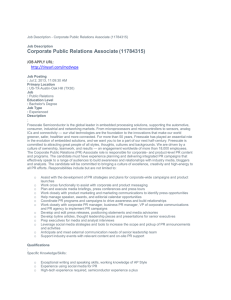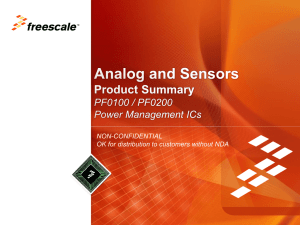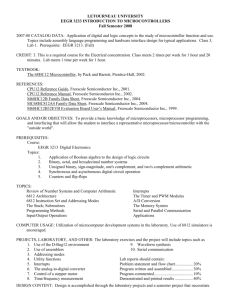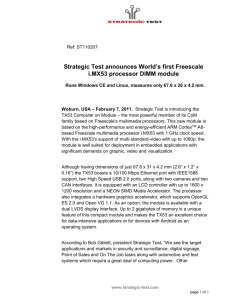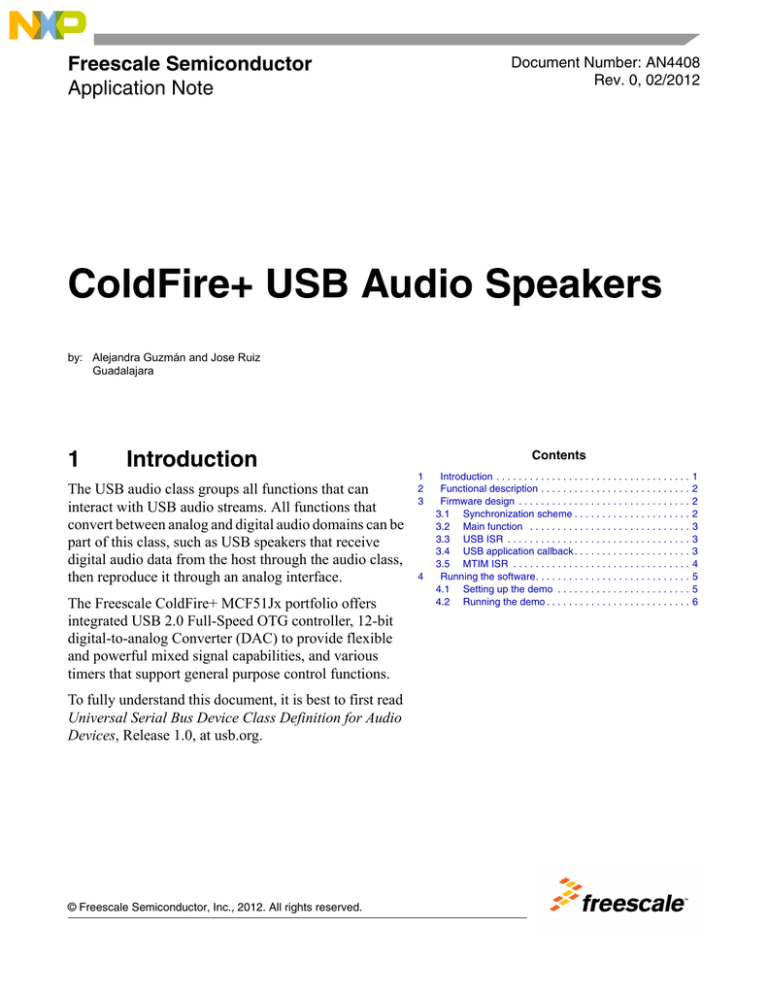
Freescale Semiconductor
Application Note
Document Number: AN4408
Rev. 0, 02/2012
ColdFire+ USB Audio Speakers
by: Alejandra Guzmán and Jose Ruiz
Guadalajara
1
Introduction
The USB audio class groups all functions that can
interact with USB audio streams. All functions that
convert between analog and digital audio domains can be
part of this class, such as USB speakers that receive
digital audio data from the host through the audio class,
then reproduce it through an analog interface.
The Freescale ColdFire+ MCF51Jx portfolio offers
integrated USB 2.0 Full-Speed OTG controller, 12-bit
digital-to-analog Converter (DAC) to provide flexible
and powerful mixed signal capabilities, and various
timers that support general purpose control functions.
To fully understand this document, it is best to first read
Universal Serial Bus Device Class Definition for Audio
Devices, Release 1.0, at usb.org.
© Freescale Semiconductor, Inc., 2012. All rights reserved.
Contents
1
2
3
4
Introduction . . . . . . . . . . . . . . . . . . . . . . . . . . . . . . . . . . .
Functional description . . . . . . . . . . . . . . . . . . . . . . . . . . .
Firmware design . . . . . . . . . . . . . . . . . . . . . . . . . . . . . . .
3.1 Synchronization scheme . . . . . . . . . . . . . . . . . . . . .
3.2 Main function . . . . . . . . . . . . . . . . . . . . . . . . . . . . .
3.3 USB ISR . . . . . . . . . . . . . . . . . . . . . . . . . . . . . . . . .
3.4 USB application callback . . . . . . . . . . . . . . . . . . . . .
3.5 MTIM ISR . . . . . . . . . . . . . . . . . . . . . . . . . . . . . . . .
Running the software. . . . . . . . . . . . . . . . . . . . . . . . . . . .
4.1 Setting up the demo . . . . . . . . . . . . . . . . . . . . . . . .
4.2 Running the demo . . . . . . . . . . . . . . . . . . . . . . . . . .
1
2
2
2
3
3
3
4
5
5
6
Functional description
2
Functional description
Pulse-code modulation (PCM) is a standard method for digital audio used in computers to digitally
represent sampled analog signals. PCM streams have two basic properties that determine their fidelity to
the original analog signal:
1. Sampling rate: number of times per second that samples are taken (in other words, 8 kHz,
44.1 kHz, 48 kHz).
2. Bit depth: number of possible digital values that each sample can take (8, 16, 24 bits). 8-bit PCM
uses unsigned data, whereas 16–24-bit PCM uses signed values.
To produce output from the digital audio sample data, after each sampling period has passed, the next
digital value is read and the output signal is shifted to the recently obtained value. Digital-to-analog
converters can be used to convert the digital audio into an accurate analog signal.
3
Firmware design
The software contained in this application note uses the Freescale USB stack, which supports audio class.
This source code solution is downloadable from www.freescale.com/usb. The stack provides
standardization, connectivity, and portability to the existing 8-bit and 32-bit Freescale microcontroller
portfolio, and speeds up general purpose and medical product development.
3.1
Synchronization scheme
This application note configures the ColdFire+ MCF51JF to work like an audio streaming interface
enabling PCM8 (8-bit depth at 8 kHz sample rate). This means that digital audio sample data needs to be
converted to audible analog output through the DAC every 125 s = 1/8 kHz.
The Modulo Timer (MTIM) module is a simple 16-bit timer with a programmable interrupt used to
generate the 125 s timely delay. Because isochronous transfers are used, it is necessary to synchronize
the 125 s delays with the USB SOF interrupt.
MTIM ISR
Start of Frame (SOF)
Figure 1. SOF and MTIM ratio
ColdFire+ USB Audio Speakers, Rev. 0
2
Freescale Semiconductor
Firmware design
3.2
Main function
The main function flow chart is shown in Figure 2. At first the firmware initializes the system. The MTIM
is configured to generate 125 s interrupts and the counter is stopped for a moment. The DAC is enabled
to work with software triggers, and the USB stack runs the software to enumerate the device as audio class.
Figure 2. Main function flow chart
3.3
USB ISR
Inside the USB interrupt service routine (usb_dci.c), the start of frame flag is checked, in case an SOF
event occurs. The MTIM counter, which is stopped from the initialization code, starts counting.
Figure 3. USB ISR flow chart
3.4
USB application callback
Whenever a reset occurs or the enumeration process is complete, the USB_App_Callback
(audio_speakers.c) function is called from the class layer. This function sets a variable so that the
application can start. It also receives data send/receive events.
The software is written in such a way that whenever data has been received, the USB application callback
stores the samples in a global buffer. Because PCM8 format is used, this means that 8-byte samples are
received at this moment.
ColdFire+ USB Audio Speakers, Rev. 0
Freescale Semiconductor
3
Firmware design
Figure 4 shows that the first sample needs to be sent at the same time that it arrives in order to be
synchronized with the sampling rate. Therefore, as soon as the global buffer finishes storing the samples,
the first sample is sent to the DAC.
Figure 4. Application callback flow chart
3.5
MTIM ISR
The MTIM interrupt (audio_mtim.c) provides timely delays to play the received digital audio data through
the DAC. Inside the MTIM ISR the software needs to:
1. Check if there is new data to be sent.
2. Convert the current digital audio data into an analog output.
3. Check if the current sample equals bit depth (8 samples); if it does then the MTIM counter is
stopped.
ColdFire+ USB Audio Speakers, Rev. 0
4
Freescale Semiconductor
Running the software
Figure 5. MTIM ISR
4
Running the software
This section explains how to use the USB audio speaker software which receives audio streams data from
a host and plays it through the DAC. Such software also supports specific requests from the audio control
interface (from host) such as mute control, volume control, and many more.
4.1
Setting up the demo
The TWR-MCF51JF is connected to a PC (host) using two USB cables and one speaker through an audio
jack output. The PC uses one USB cable to supply power to the board and to flash the software to the
ColdFire+ device. The second USB cable connects the PC host and the TWR-MCF51JF device.
ColdFire+ USB Audio Speakers, Rev. 0
Freescale Semiconductor
5
Running the software
Figure 6. Audio speaker demo setup
4.2
Running the demo
After the system has been set and flashed, use these steps to run the demo.
1. Plug USB audio device into the PC. As soon as you turn on the device, it is recognized by the host
and installed automatically. Callout shown in Figure 9 should appear on the right bottom corner of
your screen.
Figure 7. Find new hardware callout
2. After successful installation, the host indicates that the device is ready to use as shown in Figure 8.
Figure 8. Installation of USB audio device
3. To verify whether the USB audio device has been installed properly, look at the device manager
dialog.
ColdFire+ USB Audio Speakers, Rev. 0
6
Freescale Semiconductor
Running the software
Figure 9. Device manager dialog
4. Double-click on the USB Audio Device icon, and the device properties dialog appears as shown in
Figure 10.
Figure 10. USB Audio Device properties dialog
5. To verify whether the USB Audio Device has been selected as the default device or not, you must
right-click on master volume icon.
Figure 11. Master volume
ColdFire+ USB Audio Speakers, Rev. 0
Freescale Semiconductor
7
Running the software
6. After installation, the device works as a sound driver and the PC is able to control it. To show that
the control functions are received by the device, the software sends command control echoes
through the UART.
a) Open a HyperTerminal with the following properties (baud rate: 11520, parity: none, stop
bits: 1, flow control: none).
Figure 12. HyperTerminal properties
b) With the PC, send audio control interface commands such as adjusting the volume (volume,
on/off mute). The changed values are displayed on the HyperTerminal screen.
Figure 13. Volume and mute control
c) Open the Windows Media Player and then select and listen to your favorite audio.
ColdFire+ USB Audio Speakers, Rev. 0
8
Freescale Semiconductor
THIS PAGE IS INTENTIONALLY BLANK
ColdFire+ USB Audio Speakers, Rev. 0
Freescale Semiconductor
9
How to Reach Us:
Home Page:
www.freescale.com
Web Support:
http://www.freescale.com/support
USA/Europe or Locations Not Listed:
Freescale Semiconductor, Inc.
Technical Information Center, EL516
2100 East Elliot Road
Tempe, Arizona 85284
+1-800-521-6274 or +1-480-768-2130
www.freescale.com/support
Europe, Middle East, and Africa:
Freescale Halbleiter Deutschland GmbH
Technical Information Center
Schatzbogen 7
81829 Muenchen, Germany
+44 1296 380 456 (English)
+46 8 52200080 (English)
+49 89 92103 559 (German)
+33 1 69 35 48 48 (French)
www.freescale.com/support
Japan:
Freescale Semiconductor Japan Ltd.
Headquarters
ARCO Tower 15F
1-8-1, Shimo-Meguro, Meguro-ku,
Tokyo 153-0064
Japan
0120 191014 or +81 3 5437 9125
support.japan@freescale.com
Asia/Pacific:
Freescale Semiconductor China Ltd.
Exchange Building 23F
No. 118 Jianguo Road
Chaoyang District
Beijing 100022
China
+86 10 5879 8000
support.asia@freescale.com
For Literature Requests Only:
Freescale Semiconductor Literature Distribution Center
1-800-441-2447 or 303-675-2140
Fax: 303-675-2150
LDCForFreescaleSemiconductor@hibbertgroup.com
Document Number: AN4408
Rev. 0
02/2012
Information in this document is provided solely to enable system and software
implementers to use Freescale Semiconductor products. There are no express or
implied copyright licenses granted hereunder to design or fabricate any integrated
circuits or integrated circuits based on the information in this document.
Freescale Semiconductor reserves the right to make changes without further notice to
any products herein. Freescale Semiconductor makes no warranty, representation or
guarantee regarding the suitability of its products for any particular purpose, nor does
Freescale Semiconductor assume any liability arising out of the application or use of any
product or circuit, and specifically disclaims any and all liability, including without
limitation consequential or incidental damages. “Typical” parameters that may be
provided in Freescale Semiconductor data sheets and/or specifications can and do vary
in different applications and actual performance may vary over time. All operating
parameters, including “Typicals”, must be validated for each customer application by
customer’s technical experts. Freescale Semiconductor does not convey any license
under its patent rights nor the rights of others. Freescale Semiconductor products are
not designed, intended, or authorized for use as components in systems intended for
surgical implant into the body, or other applications intended to support or sustain life,
or for any other application in which the failure of the Freescale Semiconductor product
could create a situation where personal injury or death may occur. Should Buyer
purchase or use Freescale Semiconductor products for any such unintended or
unauthorized application, Buyer shall indemnify and hold Freescale Semiconductor and
its officers, employees, subsidiaries, affiliates, and distributors harmless against all
claims, costs, damages, and expenses, and reasonable attorney fees arising out of,
directly or indirectly, any claim of personal injury or death associated with such
unintended or unauthorized use, even if such claim alleges that Freescale
Semiconductor was negligent regarding the design or manufacture of the part.
For information on Freescale’s Environmental Products program, go to
http://www.freescale.com/epp.
Freescale™ and the Freescale logo are trademarks of Freescale Semiconductor, Inc.
All other product or service names are the property of their respective owners.
© Freescale Semiconductor, Inc. 2012. All rights reserved.


